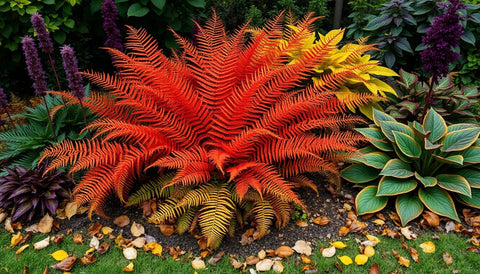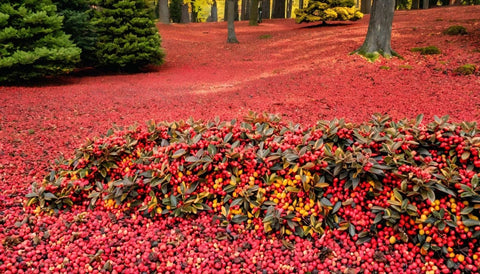Introduction
Fall gardens have a unique charm, offering an opportunity to showcase the beautiful colors and textures of the season. One standout plant that brings a lush, vibrant touch to fall landscapes is the Autumn Fern (Dryopteris erythrosora). In this post, we’ll explore how to effectively use Autumn ferns in your fall garden, enhancing its beauty and texture.

Section 1: Understanding Autumn Ferns
1.1 Description and Characteristics
- Autumn ferns grow up to 2 feet tall and wide.
- They feature striking copper-red fronds that mature to deep green.
- During fall, their coppery hues enhance garden aesthetics.
1.2 Ideal Growing Conditions
- Soil: Prefers moist, well-drained soil with a slightly acidic to neutral pH.
- Light: Thrives in partial to full shade.
- Watering: Keep the soil consistently moist but not waterlogged.
1.3 Hardiness and Care
- Hardy in USDA zones 5 to 9.
- Minimal maintenance; prune dead fronds in late fall.
- Mulch to protect roots during winter.
Section 2: Designing Your Fall Garden with Autumn Ferns
2.1 Complementary Plant Choices
Consider pairing Autumn ferns with these plants:
- Hostas: Their bold foliage contrasts well with the delicate fronds of ferns.
- Astilbes: For bright pops of color alongside the warm tones of the ferns.
- Other shade-loving ferns, such as Maidenhair or Christmas Ferns.
2.2 Placement and Spacing
Autumn ferns thrive in shaded areas, making them perfect for garden borders or woodland edges. Be sure to:
- Plant them in partial to full shade.
- Allow at least 18-24 inches of space between ferns to accommodate growth.
Section 3: Creative Uses for Autumn Ferns in the Landscape
3.1 Borders and Edges
Use Autumn ferns to create natural-looking garden borders. Combine them with low-growing perennials like heucheras to create a layered effect.
3.2 Focal Points
Autumn ferns can serve as statement pieces in the garden. Their unique color and texture contrast beautifully with elements like rocks or water features.
3.3 Container Gardening
For small spaces or patios, Autumn ferns thrive in containers. Pair them with seasonal plants like pansies or ornamental grasses for a stunning fall arrangement.

Section 4: Maintenance Tips for Autumn Ferns in Fall
4.1 Pruning and Cleanup
In fall, remove dead or damaged fronds to keep the plant looking fresh. This will also encourage healthy growth come spring.
4.2 Winter Protection
Mulch around the base of the ferns to insulate the roots during winter. In colder zones, consider covering the plants with burlap to protect them from frost.
Section 5: Benefits of Using Autumn Ferns
5.1 Aesthetic Appeal
The changing colors of Autumn ferns add richness and warmth to any fall garden, making them a fantastic choice for seasonal interest.
5.2 Ecological Benefits
Ferns are excellent for supporting local wildlife. They provide shelter for insects and small animals while also improving soil quality through organic matter accumulation.

Conclusion
Autumn ferns are a wonderful addition to any fall garden, providing texture, color, and low-maintenance beauty. Whether used as a border plant or a focal point, they enhance the landscape's appeal. Experiment with different plant combinations to find what works best in your space, and enjoy the natural elegance these ferns offer.
Call to Action
If you enjoyed these tips, be sure to subscribe to our blog for more gardening inspiration. Share your garden projects with Autumn ferns on social media to inspire fellow gardeners!































Comments (0)
There are no comments for this article. Be the first one to leave a message!